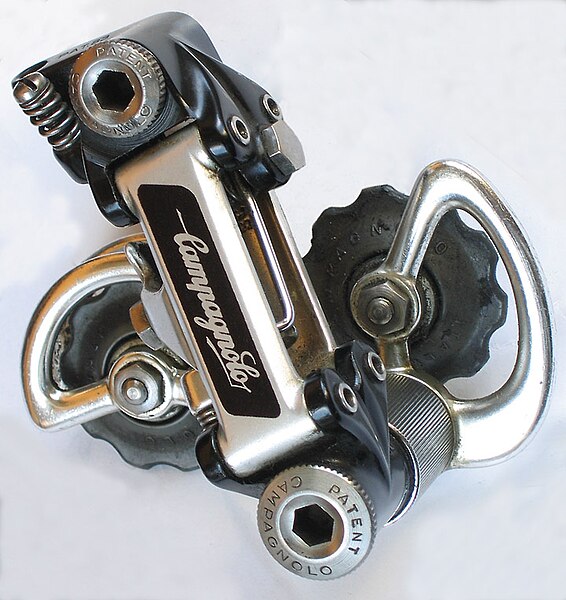I remember getting my first Campagnolo
component: a pair of Nuovo Tipo
hubs. My first nice pair of clincher wheels—Super
Champion 58 rims laced to those hubs with Robergel Sport spokes—cost the
princely (for a poor college student like me) sum of $100. The man who built them seemed like a magician
to me at the time: I simply could not
fathom what sorcery or alchemy turned all of those parts into a pair of wheels
that would take the length and breadth of state of New Jersey, on two of the
early Five Boro Bike Tours and on my first European bike tour.
It wasn’t just the parts and the build that
made them seem almost otherworldly at that time. Most clincher tires and wheels in the US at
the time were 27” and the tubes had Schraeder (the kind found on car tires)
valves. Mine were 700C and drilled for
Presta valves. That was
intentional: I used the wheels on my
Peugeot PX-10, which came with 700C tubular wheels and tires—and, of course
Presta valves. I’ve never seen a tubular
tire with Schrader valves and the only non-700C tubulars I’ve come across were
the ones made for junior racers.
Those new wheels meant that I could switch back
and forth between tubulars and clinchers without having to re-adjust the brake
blocks. (I used to tighten the cable
adjuster a bit for the tubular rims, which were narrower and loosen them for
the clinchers.) They also would fit on
other good bikes, including a couple I would acquire later—and which would, at
one time or another, be equipped with those wheels. Also, I could use the same pump on all of my tires without having to use an adapter.
Today, those wheels would seem dated to anyone not
riding a “classic” bike. The parts were
all of fine quality and lasted many rides for me. But using those Tipo hubs would limit gear
selection to whatever five- and six-speed freewheels could be found in swap
meets, on eBay or in some “accidentally” discovered stash. And, as good as
those rims were, the Mavic MA series rims, with their double-wall construction
and hooked tire beads, introduced in the early 1980s, were lighter and allowed
cyclists to use a wider variety of tires.
But even after the MA rims—and newer hub offerings from Campagnolo, Shimano,
Mavic and other companies—were introduced, there were places where cyclists
would have done almost anything to have wheels like my first good clinchers. One of those places was the German Democratic
Republic, a.k.a. East Germany. In fact,
they probably would have done illegal or simply un-approved-of things to get a
bike like mine—especially its Stronglight crank. Only Campagnolo’s Record crankset was more
prized.
That is the situation Gerolf Meyer describes in
the latest edition of BicycleQuarterly.
Like other athletes from his country, cyclists
wanted to prove themselves against the best from the West. As talented as some East German riders were,
their equipment was stuck in the 1950’s.
There were shops that took “room dividers”—Diamant “sport” bicycles with
impossibly long wheelbases—and shortened chain stays and top tubes, lowered
brake bridges and did other things to make those machines ride something like
racing bikes. Engineers and technicians
in factories and medical supply cooperatives made cable tunnel guides and other
frame fittings and bike parts on the side.
There were even mechanics and builders who could
take the crudely-machined and –finished East German components and make them
look—and even, to a degree, function—like “Campag”. In one of the most extreme examples,
Hans-Christian Smolik took a Tectoron rear derailleur—which borrowed its shape
and basic function from the Campagnolo Record but and had lettering that faced
upside down—and made it all but indistinguishable from the Real McCoy.
In the 1980s, the East German sanctioned the
development of the Tectoron derailleur and other parts in an attempt to catch
up with the technology of Western bikes and equipment. One of the ironies is that Campagnolo,
Shimano, Mavic and other Western manufacturers were innovating in ways that
would render obsolete (at least for those who simply had to have the newest and latest)
the stuff the East Germans were imitiating.
A fortunate few were able to obtain Western
components through connections—a relative who’d retired to the West (Apparently,the East
German government didn’t mind letting retirees leave, probably figuring that it
would save the state on pension costs.), a partially-subterranean “supply chain”
or Western racers the East Germans met at events like the Peace Race.
About the latter: There developed a
barter system not unlike the ones soldiers develop with those fighting
alongside, as well as on the other side, of them, complete with its own "exchange rates". (During the first Gulf War, one
French K-ration was worth five of its American counterparts.) Sometimes
the East Germans—as well as Soviet bloc riders—would trade jerseys, pins
or other souvenirs, or local delicacies. But the East Germans—and Czechs—actually
made one bicycle component that was superior to anything in the West: tubular
tires. Kowalit tubular were the stuff of
legend: a light, supple tire that wore
like iron. I never rode any myself, but
I did have a pair of Czech-made “Barum” tires that I rode, literally, to the tubes: Not even the best stuff from Clement,
Vittoria, Wolber, Michelin, Continental or Soyo (Yes, I rode tires from every one of those companies!) was anywhere near as good. Ten Kowalits --or, I presume, Barums-- could
fetch a good wheelset.
Of course, such deals had to be made “in the
shadows”, and certainly not after the race.
Can you imagine what some East German would have offered (if indeed he
or she had anything to offer) for my old Colnago?



